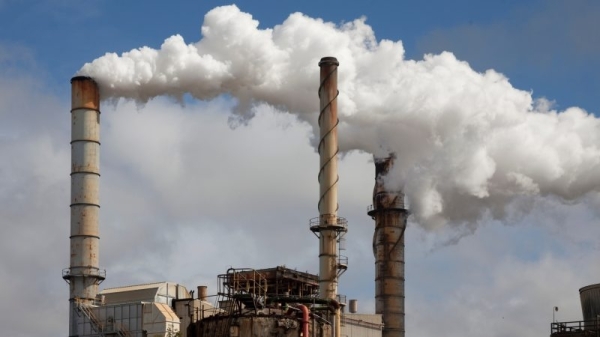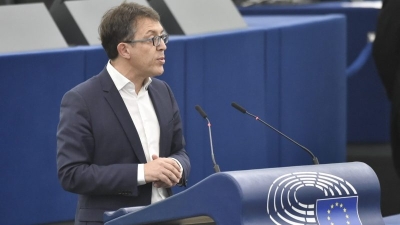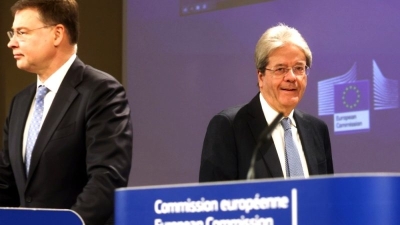US carbon capture incentives leave EU ‘lagging behind’, biofuel makers warn

Efforts to boost carbon capture and storage (CCS) in Europe are insufficient according to the biofuels industry, who say the United States offer better incentives.
CCS sees carbon taken out of the atmosphere and injected underground, usually in depleted oil and gas fields, removing its contribution to global CO2 levels.
The controversial practice has been embraced as a necessary part of Europe’s climate efforts by EU authorities, who cite the difficulty in transforming Europe’s most polluting industries to be entirely emissions-free by 2050.
The European Commission included CCS in its Net-Zero Industry Act (NZIA) released on 16 March in answer to the US’s green-industry subsidising Inflation Reduction Act.
Under the NZIA, the EU set a binding target for storage capacity of 50 million tonnes of CO2 annually by 2030. This CO2 will be kept in “strategic storage sites” across the bloc, with oil and gas producers legally required to contribute to this goal.
The figure of 50 million tonnes annually is in line with forecasted demand from industry, according to the European Commission.
However, the plan does not include direct payments for CCS, with the EU instead relying on the bloc’s carbon market, the Emission Trading System (ETS), to stimulate uptake.

EU sets world’s first target for underground CO2 storage capacity
The European Commission set out a target on Thursday (16 March) to enable 50 million tonnes of annual carbon dioxide injection capacity by 2030, a move that puts the oil and gas industry under pressure to deliver on a technology they have been peddling for years.
The CCS industry in the United States is growing, thanks in large part to the Biden administration’s decision to offer businesses a tax credit of $85 per tonne of CO2 stored.
The EU has chosen a different course of action, betting that the ETS will provide incentives for polluters to embrace CCS as a means to avoid carbon costs. The ETS sets a progressively steeper price on carbon emissions, encouraging polluting companies to cut or remove CO2.
The price of carbon is expected to rise sharply as the EU removes free allowances for carbon emissions, making emitting increasingly expensive. EU authorities say that the ETS makes the costs of emitting CO2 “predictable” for industry.
“A number of energy-intensive ‘hard-to-abate’ sectors (e.g. cement industry) are therefore increasingly developing investment plans for CO2 capture,” a Commission source told EURACTIV in emailed comments.
“Such investments are increasingly expected to give positive economic returns before 2030 based on projected carbon prices,” the source added.
Capturing CO2 from fermentation
However, not all agree that the EU’s reliance on the ETS to spur CCS is the best option.
“As a result of the financial incentives in the Inflation Reduction Act, CCS deployment is taking off in the US. While the US is taking the lead, the EU is lagging behind,” Zoltán Szabó of ClonBio Group, an Irish biofuels producer, told EURACTIV.
Those sectors not covered by the ETS are also at risk of being ignored, Szabó warned, referencing carbon spewed into the atmosphere from fermentation of agricultural products, a process used in the production of biofuels and biomethane.
As part of the brewing process, carbon is released as a by-product. This CO2 could be captured and sequestered underground, it is argued, but there is currently no incentive to do so.
“The total of this atmospheric carbon, captured first by photosynthesis then separated by fermentation, is huge,” says James Cogan, policy advisor at Ethanol Europe, a trade association.
According to him, reaching the EU’s 35 billion cubic metre biomethane target for 2030 will involve separation of 30 million tonnes of CO2. “Add in the easily separated carbon dioxide from ethanol production and the figure jumps to around 40 million tonnes. European wine and beer production could add another two million,” he wrote in an opinion piece last month.
In total, the CO2 captured from fermentation in Europe could be “as big as the emissions of countries the size of Hungary, Sweden or Ireland,” Cogan says. Without incentives to capture and store this CO2, it will be vented back into the atmosphere, he warns, describing this as “a lost opportunity of colossal proportions”.
An EU expert group has been convened to help establish rules surrounding CCS, but Szabó feels that the EU executive is not moving quickly enough given global competition.
“Chances are the EU will get bogged down in methodological complexities as the Commission appears to aim for a universal methodology for permanent storage, carbon farming and carbon utilisation,” he said.
“It will not work given the uncertainties in the latter two. Permanent storage, including fermentation based CCS or Direct Air Capture, will need to be treated separately and allowed to make progress.”
ClonBio has pushed for the EU to offer a price on carbon storage from revenues generated by the ETS through a “Contract for Difference” instrument, a move they say will unleash Europe’s CCS industry.
Market mechanism
Bellona, a Norwegian NGO, welcomed the EU’s storage capacity target as “ambitious and appropriate”, but was mixed about placing a set price on carbon storage.
“Price-setting mechanisms for CCS (such as the Hydrogen Bank) could be helpful, but the way they are implemented is crucial. If a price-setting mechanism is developed, it shouldn’t focus on the implementation of the technology itself but on the climate effect it provides,” Ana Serdoner, senior manager for industry & energy systems with Bellona, told EURACTIV.
If CCS efforts are aimed at mitigating the impact of energy-intensive sectors, “a market mechanism could be a good way to support the rollout of shared CO2 transport and storage infrastructure allowing the European industry to decarbonise at the lowest cost,” she added.
Asked about incentivising the storage of carbon from fermentation, Serdoner was cautious:
“Theoretically, the permanent storage of CO2 from fermentation could have a net effect of removing CO2 from the atmosphere, but there are many factors there that need to be taken into account to ensure that’s actually the case,” she said.
“For biogenic CO2, indirect climate impacts such as land use change are particularly important and need to be taken into account.”

The EU needs a business case for carbon removals
If Europe achieves its 2030 biomethane target it will have unwittingly created the conditions to cheaply mitigate the carbon emissions equivalent to an entire member state, writes James Cogan.



